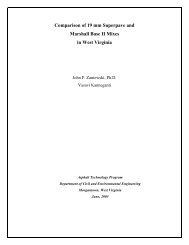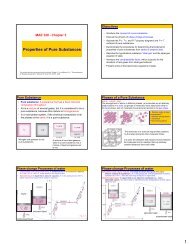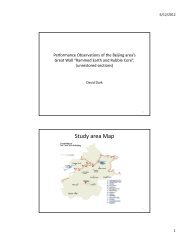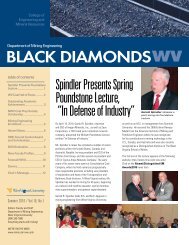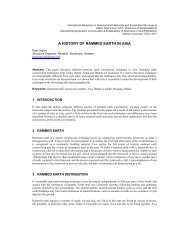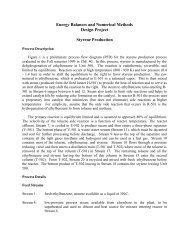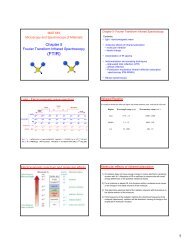Comparison of 9.5 mm SuperPave and Marshall Wearing I Mixes in ...
Comparison of 9.5 mm SuperPave and Marshall Wearing I Mixes in ...
Comparison of 9.5 mm SuperPave and Marshall Wearing I Mixes in ...
You also want an ePaper? Increase the reach of your titles
YUMPU automatically turns print PDFs into web optimized ePapers that Google loves.
47was acceptable for both <strong>Marshall</strong> <strong>and</strong> Superpave mix designs at both medium <strong>and</strong> heavy trafficlevels.Asphalt contents were calculated for these mixtures us<strong>in</strong>g Equations 2.12 to 2.16. The asphaltcontent estimates calculated from these equations were consistently too high. Us<strong>in</strong>gexperience ga<strong>in</strong>ed after complet<strong>in</strong>g a few mix evaluations achieved better estimates than wereproduced with the equations.5.1.3 Specimen Fabrication <strong>and</strong> Test<strong>in</strong>gAs prescribed under <strong>Marshall</strong> mix design, test specimens were prepared over a range <strong>of</strong>different asphalt percentages to determ<strong>in</strong>e the optimum asphalt content. This range consists <strong>of</strong>½ percent <strong>in</strong>crements with two asphalt contents above <strong>and</strong> two below the estimated asphaltcontent. Also duplicate samples <strong>of</strong> each asphalt content were made. Two maximum specificgravity, or Rice, samples were also required at the estimated asphalt content accord<strong>in</strong>g toAASHTO T209, mak<strong>in</strong>g the total number <strong>of</strong> samples needed, 12 per mix design. Maximumspecific gravity test samples were not needed for all asphalt contents s<strong>in</strong>ce the <strong>Marshall</strong> methodallows for estimation <strong>of</strong> the maximum specific gravity <strong>of</strong> the other asphalt contents from theone measured value. Equations 2.1 to 2.10 are used for this analysis.Once the aggregates for the mixtures had been comb<strong>in</strong>ed for correct weight, they were heatedto the mix<strong>in</strong>g temperature <strong>of</strong> 162 C. A sufficient amount <strong>of</strong> PG 64-22 asphalt b<strong>in</strong>der was alsoheated to this temperature shortly before the mix<strong>in</strong>g process. The mix<strong>in</strong>g bowl <strong>and</strong> mix<strong>in</strong>gw<strong>and</strong> were also heated to the compaction temperature. Mix<strong>in</strong>g temperature was <strong>in</strong>dicated <strong>in</strong>the b<strong>in</strong>der evaluation data from the Citgo Asphalt Data Sheet. This evaluation sheet also<strong>in</strong>dicated that the compaction temperature was 149 C. In a separate oven, the compactionmolds were heated to the compaction temperature <strong>and</strong> the <strong>Marshall</strong> ha<strong>mm</strong>er was placed on ahotplate.The heated aggregate mixture was then placed <strong>in</strong>to the mix<strong>in</strong>g bowl <strong>and</strong> the required amount <strong>of</strong>asphalt b<strong>in</strong>der was added. This was i<strong>mm</strong>ediately placed <strong>in</strong> the tabletop mixer <strong>and</strong> mixed untilthe aggregate <strong>and</strong> b<strong>in</strong>der was thoroughly mixed. After mix<strong>in</strong>g, the entire specimen was placed<strong>in</strong> the mold, spaded 25 times with a spatula, <strong>and</strong> placed on the compaction pedestal. Thereta<strong>in</strong><strong>in</strong>g r<strong>in</strong>g was placed over the mold, the compaction ha<strong>mm</strong>er placed <strong>in</strong> the mold <strong>and</strong>attached to the automatic lift<strong>in</strong>g device. The lift<strong>in</strong>g device was then activated to apply theapplicable number <strong>of</strong> blows to the specimen. The correct number <strong>of</strong> blows per side for <strong>Marshall</strong>medium <strong>and</strong> heavy mixtures is 50 <strong>and</strong> 75, respectively. After the compaction to one side <strong>of</strong> thespecimen was complete, the mold was then flipped over <strong>and</strong> the compaction process repeatedfor the same amount <strong>of</strong> blows. Once the compaction process was complete, the sample <strong>and</strong>mold were removed <strong>and</strong> placed <strong>in</strong>to the specimen extraction device. The specimen wasremoved from the mold <strong>and</strong> allowed to cool. This entire process was repeated for the tenspecimens used for determ<strong>in</strong><strong>in</strong>g the optimum asphalt content.



